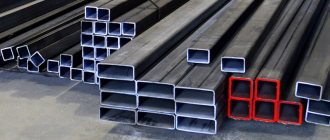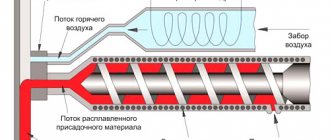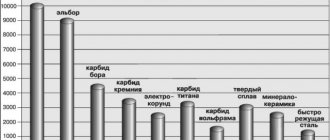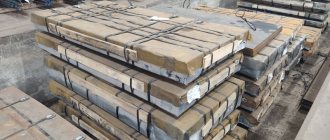The PromOborudovanie Group catalog contains a large selection of piston compressor equipment from the most famous brands. Also, you can purchase used equipment from us at affordable prices. For all questions and to order a compressor, please call.
Piston compressors are extremely popular due to a number of advantages over similar equipment. Piston models are distinguished by their maintainability, efficiency, ease of operation and reliability. The equipment copes well with frequent switching and interruptions and can be operated in high humidity levels and polluted air.
The operating principle of a single-cylinder piston compressor is as follows:
A piston compressor consists of a working cylinder, a piston, suction and discharge valves located in the cylinder cover.
When the crankshaft rotates, the connecting rod connected to it imparts reciprocating motion to the piston. In the working cylinder, due to an increase in the volume enclosed between the piston bottom and the valve group, a vacuum occurs. Atmospheric air overcomes the resistance of the spring holding the suction valve, opens it and enters the cylinder through the suction pipe (with an air filter).
When the piston moves back, the air is compressed and its pressure increases. High pressure allows you to overcome the resistance of the spring pressing the discharge valve. Compressed air opens this valve and enters the discharge pipe.
The crankshaft is driven either by an electric motor or by an autonomous engine (petrol or diesel).
Coaxial and axial devices
The crankshaft or eccentric drive of the compressor is rotated by the unit's engine - electric or internal combustion (diesel or gasoline). Based on the relative position of the motor and the compressor head, the units are divided into 2 types:
- coaxial - the engine and head are located on the same axis, and their shafts are connected directly;
- axial - the engine and the head are installed parallel to each other, and the shaft of the latter is driven into rotation through a belt drive.
Compressor units, which are required to maintain constant pressure and uniform air flow at their outlet, are equipped with a compressed gas storage device - a receiver. It is a durable, thick-walled steel container. In such units, air from the compressor head is first supplied to the receiver, where it is accumulated, and then used for its intended purpose.
Determining the performance of a piston compressor
In general, the performance of a piston compressor is a variable value depending on the suction conditions: pressure and ambient air temperature. Therefore, when talking about performance, the suction conditions must be indicated. For reciprocating compressors, the theoretical capacity is usually specified.
The theoretical capacity, or suction capacity, is equal to the volume described by the piston per unit time. It is no coincidence that this value is called theoretical productivity. It differs quite significantly from real performance. The fact is that there is always a gap between the piston in the uppermost position and the valve group. The gap forms a free volume - the so-called “harmful space”.
After injection, compressed air always remains in the “harmful space”. When the piston moves back, it expands and its pressure decreases. Therefore, the suction valve does not open immediately, but only after the pressure in the cylinder drops to the suction pressure (becomes less than atmospheric pressure).
Thus, for a certain part of the path the piston moves to idle, due to which the compressor performance decreases. This reduction in performance is determined by the performance factor of the compressor group.
conclusions
Having examined the operating features and a comparative analysis of the technical characteristics of piston and screw type compressors, we can conclude that the choice of a particular unit depends on:
- Compressor performance;
- Frequency of use;
- Required pressure;
- Areas of application.
If you have any questions about how to select a compressor, or you want to calculate the price based on specified parameters and production time, please contact us in a way convenient for you:
- By phone: 8-800-555-95-28 (free call)
- By email
- By filling out an application in our online chat.
Control of piston compressors
The operation of piston compressors is controlled using a pressure switch (pressostat). Structurally, the pressure switch is a system of springs of varying stiffness that respond to changes in pressure. To minimize the reaction to pulsations of the air flow of compressed air, the pressure switch must be connected to a place in the compressor where these pulsations are minimal. This is usually an air receiver. The operating principle of the pressure switch is as follows. The spring mechanism reacts to changes in pressure and, when the maximum operating pressure Pmax is reached (the value specified in the compressor passport), opens the power supply circuit. Accordingly, when the pressure decreases to a certain minimum value Pmin (switching pressure), the power supply circuit is closed, and the compressor begins to operate in discharge mode. This mode of operation is called intermittent.
The difference between Pmax and Pmin, the so-called “delta”, is usually 2 bar. This value significantly affects the operating mode of the compressor. If the “delta” is too small, the compressor will often turn on/off, thereby putting additional load on the electric motor and the piston group. Too large a “delta” is also undesirable, because this increases the operating time of the compressor in the discharge mode. And this, when air cooling the compressor group, can lead to its overheating.
What to do if it breaks?
- If the oil line ruptures, you will have to work hard and fix the oil line.
- The oil pump bypass valve is damaged - there is no point in repairing it, you need to buy a new one.
- There is no oil - be sure to add filtered oil of the same brand that is already in the crankcase.
- The mesh, the functionality of which includes receiving lubricant in the oil pump, is clogged - as soon as the compressor stops, the receiving mesh needs to be removed, cleaned and installed back.
- If the lubricant filter becomes clogged, it can be simply cleaned.
- The connecting rod bearings are worn out - they need to be tightened, if this does not work, then replace the bearings. It must be remembered that they should be adjusted to the shaft.
- If water gets into the oil, you will have to change the oil, then be sure to dry the system.
The video shows one of the repair cases
The principle of operation of a piston compressor is simple enough even for its operator to be a person without special technical training. Easily repairable, they also have a long service life. The devices are used everywhere - from scientific laboratories and medicine to semi-professional construction.
And while nothing better has been invented , piston compressors remain the leaders among devices that increase the pressure of gases and liquids.
Source
Design features of piston compressor groups
Piston groups are single- and multi-stage. The operating principle of a single-cylinder compressor was discussed above. Let us analyze the design features of two-cylinder piston groups.
A two-cylinder single-stage compressor has two cylinders of the same size (Fig. 2). Both of them, working in antiphase, alternately suck in air, compress it to maximum pressure and force it into the discharge line.
A two-cylinder two-stage compressor also has two cylinders, but of different sizes (Fig. 3). In the first stage cylinder, the air is compressed to a certain intermediate value, then cooled in an interstage cooler and pressed to maximum pressure in the second stage cylinder. The role of an interstage cooler is performed by a special copper tube. It provides intermediate cooling of compressed air, due to which the compression process approaches ideal, thereby increasing the efficiency of the piston group.
The dimensions of the cylinders are selected in such a way that approximately the same work is done at each compression stage.
Two-cylinder two-stage compressor groups have a number of advantages over two-cylinder single-stage groups:
- with the same engine power, two-stage compression consumes less energy than single-stage compression;
- the actual performance of a two-stage compressor is approximately 20% higher;
- In a two-stage compressor, the temperature in the cylinders is significantly lower, which significantly increases reliability and increases the service life of the piston group.
Connection diagram
Pressure switches for compressors can be for different load connection schemes. For a single-phase engine, a 220-volt relay is used, with two groups of connections. If we have three phases, then install a 380-volt device that has three electronic contacts for all three phases. For a three-phase motor, you should not use a relay for a 220-volt compressor, because one phase cannot be switched off from the load.
There are also relays with only 12 volts. For example, for a 12V wheel inflation compressor.
Flanges
The device may include additional connection flanges. Usually equipped with no more than three flanges, with a hole size of 1/4 inch. Thanks to this, you can connect additional parts to the compressor, for example, a pressure gauge or a safety valve.
Model range of FIAC piston compressors
Let's consider the design features and areas of application of piston compressors using the model range of the Italian company FIAC as an example. To eliminate gross mistakes when choosing a model, FIAC divides its compressors into three classes.
Class of household compressors "HOBBY"
This class of compressors uses a single-cylinder oil-free compressor group with direct transmission.
“HOBBY” class compressors are intended for consumers who use them infrequently, mainly for domestic purposes: for work at home, in the garage, in the country, etc. Therefore, much attention in the design of these compressors is paid to their consumer properties. They are light in weight and dimensions, have low noise levels, require virtually no maintenance, and can be transported both vertically and horizontally. The scope of application also dictates a number of special requirements. The compressor housing is made of impact-resistant polystyrene and is designed to reduce noise levels and protect the consumer from burns. The use of direct transmission between the electric motor and the compressor group made it possible to extremely simplify the design of the compressor and reduce its cost.
As an example, consider the model range of the Italian company FIAC. The basis of the series is two noise-proof models AIRBAG HP 1 and AIRBAG HP 1.5, two mobile compressors FX-95 and FX-150 and a portable compressor ECU 200. The suction capacity of HOBBY class compressors ranges from 100 l/min for the AIRBAG HP 1 model up to 205 l/min for the FX-150 model. For single-cylinder compressors with direct drive, the performance coefficient of the compressor group is 0.60-0.65. In other words, the actual compressor performance is 35-40% less than the declared suction performance.
This class of compressors is not intended for high-intensity work throughout the working day. The maximum operating time should not exceed 3-4 hours per day. The operating time of the compressor is limited by the use of direct drive.
Class of semi-professional direct drive oil compressors
The class of semi-professional piston compressors includes oil-flooded compressors with direct transmission, which use single-cylinder and two-cylinder single-stage compressor groups.
The use of lubricant made it possible to reduce the coefficient of friction and thereby lower the operating temperature of the piston group. Consequently, the intensity of the compressor increases. Therefore, the scope of application of semi-professional compressors is much wider than that of HOBBY compressors.
The suction capacity of compressors of this type ranges from 170 l/min to 400 l/min. The correction factor for the performance of the compressor group is 0.60-0.65.
Semi-professional direct drive compressors find the widest application in a wide variety of small business areas: in car repair shops, shoe shops, furniture workshops, i.e. where there is no such load as in serial and small-scale production.
This is not a complete list of consumers who successfully use this type of compressor in their professional activities. The class of semi-professional compressors has also found application in the field of personal consumption: for the garage, home, and cottage. It, like the “HOBBY” class, is indispensable for minor car repairs, painting work, powering household pneumatic tools, etc.
Now in the model range of the Italian company FIAC, the most popular semi-professional compressors are the GM series compressors. The compressor groups GM193 and GM244 used on them are well known to domestic consumers from the COSMOS and SUPERCOSMOS compressors on which they were installed previously. GM compressors have a suction capacity of 240-260 l/min, and receivers with a volume of 24 l and 50 l.
The most powerful semi-professional compressors are the VX series models. They use a two-cylinder, single-stage V-shaped piston group.
Thanks to the use of two cylinders, VX compressors have twice the performance of single-cylinder compressors. However, the power consumption is also twice as high. VX compressors are already quite serious equipment that allows you to supply powerful pneumatic devices with compressed air.
Class of industrial piston compressors with belt drive
The class of industrial piston compressors includes oil-flooded belt-driven compressors that use two-cylinder single-stage compressor groups and two-cylinder two-stage compressor groups.
In the line of FIAC compressor equipment, models AB 360 and AB 515 have a two-cylinder single-stage piston group, and models AB 670, AB 850 and AB 981 have a two-cylinder two-stage piston group.
The use of a belt drive made it possible to significantly reduce the crankshaft speed (up to 1000-1500 rpm) compared to the rotor speed of the electric motor (about 3000 rpm). The suction capacity of compressors of this class ranges from 250 l/min to 2000 l/min. The correction factor for the performance of the compressor group is 0.7-0.75.
The scope of application of industrial piston compressors is extremely diverse: these are car services, small workshops and industrial enterprises, workshop areas at large enterprises, etc.
For about 10 years, the most popular FIAC industrial compressors have been the AB series compressors. These models fully satisfy the requirement of intensive operation and meet all standards for industrial compressor installations.
AB compressors are supplied in various design options on horizontal receivers with a volume of 50 l, 100 l, 200 l, 270 l and 500 l. Those who are limited by free space for installing a compressor may be interested in models with a vertical receiver with a volume of 100 l and 270 l.
Based on AB compressors, AVT models, the so-called “tandems”, are produced. The “tandem” design involves installing two compressor groups on one receiver. The operation of a “tandem” has no fundamental differences from the operation of a conventional compressor. In fact, these are two compressors using one common receiver. To relieve peak loads at the moment of switching on, “tandems” use an electronic control device. First, one compressor group is turned on, and then, after the set time has elapsed, the second. AVT compressors are especially attractive for those whose compressed air consumption can vary significantly during a work shift.
Since 2009, FIAC has been supplying the Russian market with two more series of industrial compressors – AB “LONG LIFE” and SCS.
AB series piston compressors “LONG LIFE”
The AB “LONG LIFE” series is designed specifically to increase the continuous operation time of a piston compressor. This time largely depends on the temperature of the piston group. Indeed, it is the overheating of the piston group that is one of the main reasons limiting the intensity of use of a piston compressor.
In turn, the temperature of the piston group is significantly affected by the crankshaft rotation speed: the faster the compressor, the faster the heating occurs (all other things being equal). In addition, it is important to carry out effective cooling of the piston group. It is provided by a fan, which is also a drive pulley.
Various models of AB series compressors have crankshaft speeds from 1000 to 1450 rpm. AB “LONG LIFE” compressors are “slower”, the rotation speed does not exceed 1000 rpm. And to improve heat removal from the piston group, a special design of an oversized fan drive pulley has been developed.
According to FIAC specialists, AB “LONG LIFE” industrial compressors are an excellent solution for equipping enterprises with a two-shift (12-16 hours) operating mode. Moreover, this opinion is supported by the unprecedented decision to increase the warranty period for AB “LONG LIFE” compressors to 2 years!
SCS piston compressors
The SCS series are industrial piston compressors in a noise-proof design. For comparison: the noise level of SCS compressors is 66-68 dB, while for AB compressors it is on average 74-78 dB. Due to their low noise level, SCS compressors can be installed directly in the work area, while the installation of an AB compressor usually requires a separate room.
Those for whom the quality of compressed air is important will be interested in the SCS ABS model equipped with a built-in refrigerated dryer with a dew point temperature of +3°C. This model can be successfully used in car repair shops, painting areas, packaging lines, in the food industry, in printing, etc.
Design differences
Design alternatives used in the production of piston compressors:
with belt or coaxial drive
oil-filled and oil-free.
Each design solution is aimed at achieving a specific goal.
Direct transmission
The coaxial drive is designed to reduce the weight and dimensions of the structure. This solution eliminates the need for bulky pulleys, belts and ratchets. Torque is transmitted directly from the engine shaft to the crank mechanism of the cylinder block. The disadvantage of this design is difficult cooling.
The operating mode of direct drive equipment is never more than 1:2, that is, it works for 20 minutes and rests for 40 minutes. Sometimes the ratio is even smaller - up to 1:4. This means continuous operation!
V-belt drive
This is a traditional design that has been used since the first piston compressors. Since then, only minor improvements have been made.
A massive ratchet ensures the overall smooth operation of the cylinder-piston group. This is the first advantage. The ratchet is shaped like a wheel. In modern models, the spokes are made in the form of blades, which create an air flow directed towards the piston head.
Additional cooling is the second plus.
The third advantage is ease of maintenance and repair. Most of the wear and tear is on the belts, which are easy to replace. During operation, you should monitor their tension and tighten if necessary. You do not need to disassemble the compressor to perform these steps.











